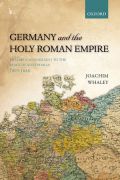
Germany and the holy roman empire: volume i: maximilian i to the peace of westphalia, 1493-1648
Whaley, Joachim
In the first single-author account of German history from the Reformation tothe early nineteenth century since Hajo Holborn's study written in the 1950s,Dr Whaley provides a full account of the history of the Holy Roman Empire. Volume I extends from From Maximilian I to the Peace of Westphalia. Germany and the Holy Roman Empire offers a new interpretation of the development of German-speaking central Europe and the Holy Roman Empire or German Reich, from the great reforms of 1495-1500 to its dissolution in 1806 after the turmoil of the French Revolutionary and Napoleonic Wars. Going against the notion that this was a long period of decline, Joachim Whaley shows how imperial institutions developed in response to the crises of the sixteenth and seventeenthcenturies, notably the Reformation and Thirty Years War, and assesses the impact of international developments on the Reich. Central themes are the tensionbetween Habsburg aspirations to create a German monarchy and the desire of the German princes and cities to maintain their traditional rights, and how the Reichdeveloped the functions of a state during this period.The first single-author account of German history from the Reformation to theearly nineteenth century since Hajo Holborn's study written in the 1950s, it also illuminates the development of the German territories subordinate to the Reich. Whaley explores the implications of the Reformation and subsequent religious reform movements, both Protestant and Catholic, and the Enlightenment for the government of both secular and ecclesiastical principalities, the minor territories of counts andknights and the cities. The Reich and the territories formed a coherent and workable system and, as a polity, the Reich developed its own distinctive political culture and traditions of German patriotism over the early modern period.Whaley explains the development of the Holy Roman Empire as an early modern polity and illuminates the evolution of the several hundred German territories within it. He gives a rich account of topics such as the Reformation, the Thirty Years War, Pietism and baroque Catholicism, the Aufklrung or German Enlightenment and the impact on the Empire and its territories of the French Revolution and Napoleon. It includes consideration of language, cultural aspects and religious and intellectualmovements. Germany and the Holy Roman Empire engages with all the major debates among both German and English-speaking historians about early modern Germanhistory over the last sixty years and offers a striking new interpretation ofthis important period.Volume I extends from the late fifteenth century through to the Thirty Years War. INDICE: I: Introduction: Narratives of Early Modern German History II. Germany and the Holy Roman Empire in 1500 Origins and Frontiers The Reich as a Polity Fragmented Territories The Reich and the German Nation III. The Reform ofthe Reich and the Church c. 1490-1519 The Reformation Era in German history The Reich under Maximilian I Reich, Papacy, and Reichskirche Religious Renewal and the Laity Humanism in the Reich The 'Print Revolution' and the Public Sphere Economic Landscapes, Communities, and their Grievances Martin Luther and the 'Luther affair' 1517-19 IV. Charles V and the Challenge of the Reformation in the 1520s The Reich During the First Decade of Charles V Luther and ImperialPolitics, 1519-1526 Luther and the German Reform Movement Alternative Reformations and the Dominance of Lutheranism The Knights' War, 1522-23 The Peasants'War 1525 Reformation in the Cities V. Mastering the Reformation c. 1526-1555 The Emergence of Protestant Territories The Persistence of Catholicism CharlesV, Ferdinand, and the Reich in Europe The Establishment of Protestantism, 1526-1530 The Schmalkaldic League, its Counterparts and the Politics of the Reich, 1530-1541 Charles V as 'Lord of Germany', 1541-58 The Triumph of the Reich, 1548-1555 VI. Managing the Peace 1555-1618 Contours of the 'Confessional Age' Emperors, Imperial Officials, and Estates after the Peace of Augsburg Constitutional developments after 1555: Reichstag, Kreise, Courts, and Legislation TheReich in Europe Managing the Domestic Peace, 1555-c.1585 The Consensus Falters, c. 1585-1603 Paralysis, 1603-1614 Problems of the Habsburg Dynasty The Reich in the Reign of Emperor Matthias, 1612-19 The Crisis of the Habsburg lands VII. The German Territories and Cities after 1555 Problems of Interpretation A Benign Environment? State Formation? Domestic Order and Defence Confessionalisation? Finance, Taxation, and Estates The Resurgence of the Courts Imperial Cities Responding to Crises VIII. The Thirty Years War 1618-1648 The Thirty Years War in German History What Kind of Conflict? The Reconquest of Austria and Bohemia, 1618-1623 Ferdinand Victorious Denmark and the War for the Reich, 1623-29 What Kind of Reich? Sweden and the Defence of German Liberties, 1630-35 Wallenstein and After France, Sweden, and the German Way, 1635-48 The Peace of Westphalia The Impact of the War on German Society The Thirty Years War and theGerman Polity Glossary Abbreviations Bibliography
- ISBN: 978-0-19-873101-6
- Editorial: Oxford University
- Encuadernacion: Cartoné
- Páginas: 752
- Fecha Publicación: 24/11/2011
- Nº Volúmenes: 1
- Idioma: Inglés
